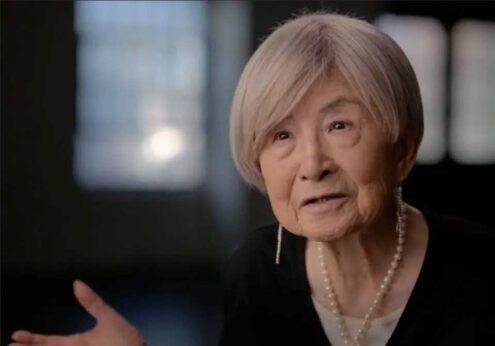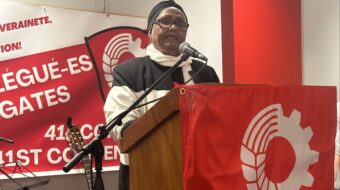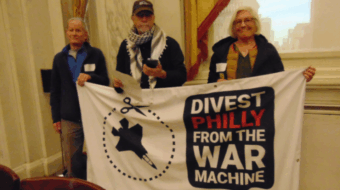
WASHINGTON—When the atomic bomb was dropped on her hometown 79 years ago, “We had no idea what happened,” Hideko Tamura says.
And in some respects, especially the drift of radiation and the total number of casualties there and at Nagasaki, the full story may be forever hidden.
Tamura was an elementary school child that morning of August 6, 1945. She’s now one of a dwindling band of special people, the hibakusha: Survivors of the uranium atomic bomb the U.S. plane Enola Gay dropped on Hiroshima at 8:15 am, Japanese time, and of the plutonium bomb another bomber dropped on Nagasaki three days later.
“It was pitch dark in the mushroom cloud that I was in,” she recalled at a commemorative symposium in D.C., via zoom. “I thought it would go on forever and ever. It started to clear up after 15 minutes. But it wiped out civilization…and we were all walking around with death.
“Thirty years afterwards, there was still evidence of plutonium in the water of Nagasaki,” Tamura said. Another panelist, an M.D., Gwen DuBois, reported radiation from that bomb’s plutonium mushroom cloud drifted all the way down to Australia.
Tamura was the featured speaker at a D.C. memorial commemoration for the victims of the bomb, held on the evening of August 5 concurrently with other observances around the world, including one at the International Peace Park in Hiroshima.
Three minutes of silence, somber speeches and warnings the globe is closer to a nuclear Armageddon than it has been in decades marked those ceremonies, thanks to the current nuclear tinderbox in the Middle East.
That tinderbox features “a madman,” one speaker said—Israeli Prime Minister Benjamin Netanyahu—with a finger on a nuclear trigger versus a theocratic government, Iran, developing its own trigger within months.
The U.S. proxy war against Russia presents another danger of nuclear war which is why the world’s “atomic clock,” is the closest it’s been in decades to a nuclear midnight: 90 seconds.
The U.S. and Russia hold 90% of the world’s nuclear warheads, speakers said. Scientists calculate the ensuing destruction of a Russia-U.S. nuclear war would lay waste to wide swaths of the globe for many years and kill five billion of the world’s eight billion people.
“Deterrence is crazy,” said one panelist of the theory that atomic nations use to justify their enormous spending on bombs, bombers, submarines, and missiles. Another noted such spending enriches the military-industrial-congressional complex and its Wall Street backers. “It’s in their interest” to build new bombs and upgrade arsenals. The U.S. military will spend billions to do so, all to the bomb-makers.
Seek complete nuclear disarmament
All of this leads Tamura and other panelists at the D.C. event to campaign passionately for complete nuclear disarmament, a goal their worldwide movement of remembrance has had for decades.

But only Tamura had on-site memories of the death and destruction the A-bomb caused. Other panelists could fill in some blanks—but not all—from later records. The post-war U.S. occupation army, headed by Gen. Douglas MacArthur, confiscated medical notes doctors made about examinations of survivors. The notes have never been seen again.
“We had no idea what happened until MacArthur left,” Tamura explained. “It was only some time later that we learned about people who were burned alive” in the raging fires the A-bomb set off “or who melted” to death “or who suddenly bruise” from internal injuries and bleed to death.
Now the U.S. and Russian nuclear arsenals are filled with even more powerful hydrogen bombs. The U.S. has led the way in scrapping the treaties, one by one, which they previously signed to control nuclear arsenals.
The next treaty, limiting intermediate range ballistic missiles, expires in two years. It will probably not be renewed, warned John Steinbach, head of the Washington chapter of the organization that campaigns, in the name of atom bomb survivors, for abolishing nuclear weapons.
A key non-proliferation treaty, signed seven years ago, and taking effect three years ago, covers most of the world’s countries. But no nuclear-armed nations–The U.S., Russia, China, the Democratic People’s Republic of Korea, Great Britain, France, Israel, India and Pakistan—have signed it. Neither has Iran. The U.S. and Russia definitely have H-bombs.
“An H-bomb releases radiation in a fission-fusion-fission sequence,” explained Dr. Gwen DuBois of the Chesapeake Physicians for Social Responsibility. “The temperature can be as high as a hundred million degrees Centigrade” inside the uranium or plutonium bomb’s thermal blast and ensuing fireball.
“It creates flash burns and flash blindness. It collapsed buildings, and anything that wasn’t tied down, including people, is picked up and thrown around.” And anyone within half an hour of the fast-moving fireball in Hiroshima “was asphyxiated.”
Planned to hit other targets
The U.S. military planned to hit other city targets, all on Japan’s west coast. Documents reveal the Hiroshima bomb did not move the Japanese government, but the Nagasaki bomb did. Emperor Hirohito overrode his generals and ordered his civilian government to negotiate a surrender to end World War II.
The West Coast targeting, one speaker said, was to “send a message” to the Soviet Union that the U.S. did not need and did not want the U.S.S.R’s help in the final efforts to end the war. It was meant to signal that the U.S. was now the supreme power on Earth.
Historians have debated U.S. motivations ever since. Some hew to President Harry Truman’s justification that dropping the bomb saved a million U.S. service members from death and injury in a long and bloody invasion of Japan’s home islands. Others side with the warning message to the Soviet Union and to the entire world.
The panelists offered several solutions pointing towards total nuclear disarmament, even while admitting they’d hit strong opposition from vested interests, such as weapons, missile, and aircraft manufacturers, whose profits depend on building planes, missiles, submarines, and nuclear bombs.
One solution is a mass people power movement, recreating the “nuclear freeze” crusade of 40 years ago. At its height, that movement drew a million people to New York City’s Central Park. It also prompted U.S. leaders to join the Soviet Union in negotiating at least one of the now-dead arms control pacts ended unilaterally by the United States.
Another is to stop U.S. imperialist exploitation of developing nations, notably the Democratic Republic of the Congo and its Katanga province. Katanga supplies four-fifths of the bombs’ uranium—of the highest quality–and other vital minerals, panelists said. The rest of the uranium comes from Native American lands in Saskatchewan and under Navajo land in the U.S. Southwest.
That exploitation, said John Steinbach, who organized the D.C. session, goes hand-in-hand with capitalist and imperialist dehumanization of non-white people. They’re forced into labor for bomb materials or suffer from the bomb’s radioactive effects—including downwind and underground radiation which causes cancer.
Dehumanization appears, he adds, in actual U.S. wars in Iraq, Afghanistan, and Indochina and “proxy wars” in Ukraine, Chile, Guatemala, and Gaza. Another speaker added Korea to the actual war list.
“The people in the Congo don’t matter” to their exploiters, said Steinbach. “Just like the people in Hiroshima and Nagasaki didn’t matter.” To those who made and dropped the bombs, “they’re subhuman.”
A third is to gather more co-sponsors for the HALT Act, legislation by Rep. James McGovern, D-Mass., reinstating the nuclear freeze and restarting nuclear arms reduction talks. McGovern first introduced that measure four years ago, when then-President Donald Trump was repudiating arms control treaties. It went nowhere. He reintroduced it last year. In the Republican-run House, it’s still gone nowhere.
“Our country is going in the wrong direction on nuclear disarmament and arms control,” McGovern said four years ago. “Instead of working to lower the threat of nuclear weapons, President Trump has withdrawn the United States from treaty after treaty that limit the use and deployment of nuclear weapons.” Trump is again the GOP presidential nominee.
“He’s even announced he wants to start explosive nuclear testing again,” McGovern said of Trump then. “This is not an academic debate. Our world has come perilously close to a catastrophic nuclear war before, and every day the president’s actions are making such an event more and more likely. It’s time to hit the brakes on his dangerous escalation, honor our existing treaty obligations, and then put an end to nuclear weapons before they put an end to us.”










